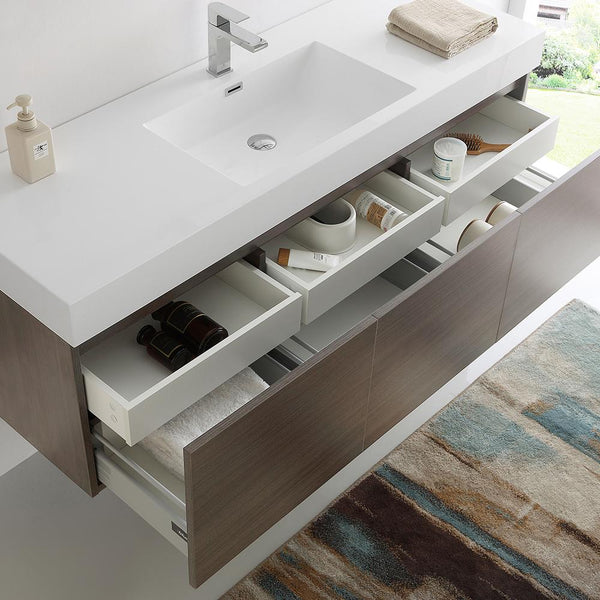When remodeling the bathroom or designing a new area, one of the most significant choices you will make is what size to go with your vanity. It can seem like such an easy selection, but vanity size affects all aspects — from morning convenience to the way in which your bathroom flows.
Whether you're creating a small powder bathroom or a large master bathroom, having an idea of the standard bathroom vanity dimensions and how it compares to the standard bathroom sink size can make your planning much simpler. Let's look at your best bets for your space so you'll have a great-looking vanity and even greater function.
Understanding Standard Vanity Dimensions

Single sink bathroom vanities come in all sizes, but there are some standard widths used throughout the industry as points of reference.
The most commonly used standard sizes for single sink installations are:
24 inches – Better suited for small bathrooms or half-baths.
30 inches – An upgrade in storage without occupying too much space.
36 inches – An extremely popular size that strikes a balance between functionality and footprint.
42 inches – Provides extra counter and cabinet space, ideal for medium to large bathrooms.
48 inches – Still a single-sink vanity, but this size provides ample storage and surface space.
As far as depth goes, most standard vanities are between 20 to 21 inches from front to back, and standard height generally ranges from 32 to 36 inches, depending on whether you opt for a modern "comfort height" or a traditional vanity.
Knowing these measurements is the initial step in choosing a vanity that will suit both your space and your requirements.
Standard Bathroom Sink Size Defined
Though vanities differ in width, the typical bathroom sink size typically remains within a smaller category. Most undermount or drop-in sinks range between 16 to 20 inches diameter for round models, or 19 to 24 inches wide and 16 to 23 inches front-to-back for rectangular models.
This range coincides with standard bathroom vanity widths, providing space for a centered sink with counter space on both sides. In selecting a vanity, be certain that the sink you intend to use will fit nicely without taking up drawer or cabinet space.
Remember, too, that some contemporary vanities have integrated sink countertops that are one continuous piece. Then the sink size is constructed to fit the vanity and usually comes in standard sizes — but double-check before buying anyway.
Matching Vanity Size to Bathroom Layout
Selecting the ideal vanity size isn't necessarily about math — it's about how those figures function in your real space.
When you're equipping a powder room or tiny half-bath, a 24" or 30" vanity will probably provide you with just the right amount of storage and counter area without over-taking the space. In these areas, you'll need a vanity that seems proportionate, won't interfere with door swings, and accommodates easy movement.
In a smaller bathroom, like most guest suites or minor master baths, a 36" to 42" vanity is an intelligent decision. These widths provide extra cabinet room and countertop length, making everyday use more convenient without consuming floor space.
For master ensuites and larger bathrooms, a 48" single sink bathroom vanity has plenty of space for toiletries, decor, and even two storage drawers — all without compromising a streamlined, single-sink look.
As you plan your layout, always consider plumbing placement, door and toilet clearance, and walking area. A gorgeous-sized vanity will be useless if it interferes with the way you navigate the room.
Storage vs. Space – Finding the Right Balance
There is always a compromise in the design of bathrooms: floor space vs. storage.
Less spacious vanities are perfect for minimalist bathrooms or when there is little space, but they typically require the loss of cabinet space or the number of drawers. Ampler vanities, although offering additional storage, can make a small room crowded or even narrower than it already is.
The sweet spot is recognizing how much storage you actually require. If your bathroom is situated next to a linen closet, or your everyday essentials are limited, a 30" or 36" vanity may be more than sufficient. However, if your vanity is the sole storage point, reaching a 42" or 48" width may be the better idea — provided that your bathroom can accommodate it.
Also pay attention to the way drawers and doors open. Broader vanities tend to have more elaborate drawer arrangements, which are fabulous for organization but need additional clearance.
Tips on Making the Best Choice
Don't make the final decision just yet. Following are a few useful tips that you should take into consideration before making your ultimate choice:
Take your measurements very carefully — don't forget baseboards, molding, or rough walls that will affect fit.
Factor in sink style — vessel sinks sit on top of the vanity, while undermount sinks are installed underneath the counter. This can affect usable countertop space.
Plan for faucet height and placement, especially if you’re choosing a vanity with a backsplash or mirror above it.
If standard bathroom vanity sizes don’t suit your layout, consider custom or semi-custom vanities that allow for size adjustments without compromising design.
Final Thoughts
Choosing the correct vanity size is not merely a matter of measurements — it's about the functionality and atmosphere of your bathroom on a daily basis. With knowledge of the typical bathroom vanity sizes and how they match with the typical bathroom sink size, you can have confidence in picking a vanity that fits your daily needs and fits your design ambitions.
Whether you’re optimizing for storage, maximizing space, or simply refreshing your look, there’s a perfect vanity size out there for you. Just remember: measure twice, plan ahead, and don’t be afraid to customize if the standard options don’t check all your boxes.








